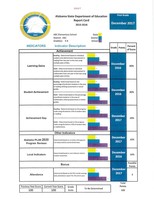In December, school systems across the state will be given A through F grades on a new report card system developed by the Alabama legislature.
During last week’s Baldwin County Board of …
This item is available in full to subscribers.
Please log in to continue |


In December, school systems across the state will be given A through F grades on a new report card system developed by the Alabama legislature.
During last week’s Baldwin County Board of Education work session, Joyce Woodburn, Baldwin County Schools’ academic dean, gave a presentation to board members to help them better understand how the report cards worked before the board was given the scores later this year.
Woodburn said all but two of the county’s schools would be receiving report cards at the end of the year.
“K through 3 schools do not receive report cards, so Fairhope Elementary and Elberta Elementary would not be included on those lists,” Woodburn said.
Woodburn told the board the report cards would be broken down by several different criteria in order to determine a score and that the categories would be broken down by elementary/middle school and high school levels.
Woodburn said of the percentages that make up the scores, the largest percentage would come from scores derived from the state’s standardized tests.
“The biggest chunk of records is based on scores on the ASPIRE exam or the AAA, which is the exam for students with special needs,” Woodburn said.
Woodburn added that on the December report card, the schools will not receive an overall grade, but mini grades in specific areas.
For the elementary and middle schools, 30 percent of the grade in 2017 will be assigned through students’ achievement on the standardized exams. 40 percent of the grade will come from “Learning Gains,” which Woodburn said would compare student growth over two consecutive years.
“Based on how much students’ scores improve over that time, we’ll be given certain amounts of points that help build that letter grade rating,” Woodburn said.
The “Local Indicator” portion will make up 10 percent of the elementary and middle schools’ scores.
“For the local indicator, this shows a school’s establishment of a goal and measures how well that school achieves that goal within the time frame,” Woodburn said.
School officials told the board some examples of “Local Indicators” already in place included the implementation of the “Leader in Me” program at many of the schools, to see if there is a reduction in discipline or an increase in attendance.
Woodburn said another indicator component would be added next year that was still being developed — the Alabama Plan 2020, which would count for 10 percent of the schools’ scores.
The elementary/middle school scores are rounded out by a final category called “Achievement Gap.”
“In this category, we would receive points for taking the lowest scoring students and raising them up on their scores where we can,” Woodburn said.
For the high school levels, student achievement on standardized testing would total 20 percent of the overall grade, local indicators would be 5 percent and the graduation rate would amount to 20 percent of the grade.
“For the graduation rate, the state will set the bar for what you have to achieve,” Woodburn said.
Other sections that will be added in 2017 include a College and Career Readiness component that will be 20 percent of the grade, which could include benchmark ACT scores, qualifying scores on AP exams, military enlistment, dual enrollment credits and other career program indicators or approved industry credentials.
Learning Gains will count for 30 percent of the score and the yet-to-be developed Alabama Plan 2020 component will comprise 5 percent of the overall score.
Superintendent Eddie Tyler said many of the variables associated with the scores were still being developed, which could skew the results of the report cards.
“This whole thing is really in a state of flux right now,” Tyler said. “This thing could be totally blown apart by the people developing this and could change as it’s being implemented. Several school leaders from the across the state have some major concerns about portions of the testing involved, especially the writing portion and how it’s being graded. There are just a lot of questions that still remain to be answered on this process.”
Tyler said school staff across the county are looking into the data even before the report card grades hit to try to find ways to increase and improve performance.
“One thing we’re definitely looking at improving is trying to get these kids to take these tests seriously, across the board,” Tyler said. “There are major ramifications if they don’t, and we feel that in some of these cases, the scores we’re seeing are not indicative of any major problem other than the kids just not caring about taking those tests.”
Woodburn also informed the board that the test scores for the state schools would already be somewhat skewed because the state was grading on a curve.
“The top 6 percent will receive an A,” Woodburn said. “The bottom 6 percent will automatically receive an F, so everyone else will shake out somewhere in between that based on the system they devised.”
Woodburn said that whatever the scores may be, Baldwin County’s schools were already working to find ways to better implement the data into better classroom instruction.
“We have to be data driven and we have to figure out as a district what we’re doing that is working and what is not working,” Woodburn said. “We’re going to train the teachers how to use that data in individual classrooms and help them find ways to become more efficient.